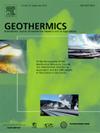Spatial distribution of mercury in geothermal springs and its correlation with tectonic setting in the Bayan Har block of Tibetan Plateau, China
IF 3.5
2区 工程技术
Q3 ENERGY & FUELS
引用次数: 0
Abstract
Mercury (Hg) serves as a pivotal tracer in geothermal systems, elucidating both deep lithospheric processes and surficial environmental dynamics. Constraining the sources and distribution of Hg in hot springs as well as its behavior is essential for unraveling subsurface fluid-rock interactions and assessing potential environmental risks. However, the distribution patterns of Hg in geothermal systems, particularly in tectonically active regions, remain poorly understood. This research investigated the distribution of thermal Hg across the Baryan Har block within the Tibet Plateau, a region featured by intense tectonic activity. Through integrated geochemical analysis of 58 springs, we revealed spatial variations in dissolved Hg concentrations (0.51∼50.66 ng/L, with an exceptionally high value of 1100.5 ng/L), exhibiting relatively higher Hg enrichment in the springs along active fault boundaries (44.35±186.99 ng/L) than that in intra-block region (4.16±4.69 ng/L). Geochemical data suggested that non-geological factors (including atmospheric precipitation and anthropogenic activity) and water-rock interactions involving Hg-bearing minerals were not the primary factors influencing the observed Hg distribution. The positive correlation between Hg and chloride concentrations in springs near block boundary fault indicated that deep fluids might be a significant source of Hg. Additionally, the spatial correlation between Hg concentrations, shear strain rates, and heat flow further confirmed the impacts of tectonic regime on the migration and enrichment of Hg. This research underscores the significance of tectonic activity on governing Hg distribution in geothermal systems, providing a better understanding for the geochemical behaviors of Hg in tectonically active regions and its potential environmental implications.
青藏高原巴颜喀尔地块地热泉中汞的空间分布及其与构造背景的相关性
汞(Hg)作为地热系统的关键示踪剂,阐明了深层岩石圈过程和地表环境动力学。控制温泉中汞的来源和分布及其行为对于揭示地下流体-岩石相互作用和评估潜在的环境风险至关重要。然而,汞在地热系统中的分布模式,特别是在构造活跃地区,仍然知之甚少。本文研究了青藏高原内构造活动强烈的巴里安哈尔地块的热汞分布。通过对58条泉水的综合地球化学分析,我们发现了溶解汞浓度的空间变化(0.51 ~ 50.66 ng/L,其中异常值为1100.5 ng/L),表明沿活动断层边界的泉水中汞的富集程度(44.35±186.99 ng/L)高于块内区域(4.16±4.69 ng/L)。地球化学数据表明,非地质因素(包括大气降水和人为活动)和含汞矿物的水岩相互作用不是影响观测到的汞分布的主要因素。在地块边界断裂附近的泉水中,Hg与氯离子浓度呈正相关,表明深部流体可能是重要的Hg来源。此外,Hg浓度、剪切应变速率和热流的空间相关性进一步证实了构造制度对Hg迁移和富集的影响。为构造活动区汞的地球化学行为及其潜在的环境意义提供了更好的认识。
本文章由计算机程序翻译,如有差异,请以英文原文为准。
求助全文
约1分钟内获得全文
求助全文
来源期刊

Geothermics
工程技术-地球科学综合
CiteScore
7.70
自引率
15.40%
发文量
237
审稿时长
4.5 months
期刊介绍:
Geothermics is an international journal devoted to the research and development of geothermal energy. The International Board of Editors of Geothermics, which comprises specialists in the various aspects of geothermal resources, exploration and development, guarantees the balanced, comprehensive view of scientific and technological developments in this promising energy field.
It promulgates the state of the art and science of geothermal energy, its exploration and exploitation through a regular exchange of information from all parts of the world. The journal publishes articles dealing with the theory, exploration techniques and all aspects of the utilization of geothermal resources. Geothermics serves as the scientific house, or exchange medium, through which the growing community of geothermal specialists can provide and receive information.
 求助内容:
求助内容: 应助结果提醒方式:
应助结果提醒方式:


